Hewlett Packard Enterprise (HPE), headquartered in Houston, Texas, is one of the key players in the enterprise technology solutions market. The company was established in 2015 following the split of the original Hewlett-Packard company, which allowed it to focus on delivering advanced IT products and services primarily targeted at large enterprises and institutions. Since then, HPE has consistently built its position as a provider of comprehensive IT infrastructure, combining traditional server solutions with modern cloud technologies and data management services.
Today, Hewlett Packard Enterprise is one of the leaders in the global enterprise technology market, offering a broad portfolio that includes servers, storage systems, networking, as well as cloud solutions and consulting services.
Start investing today or test a free demo
Create account Try a demo Download mobile app Download mobile app
Hewlett Packard Enterprise Portfolio
The Hewlett Packard Enterprise (HPE) portfolio is a comprehensive and advanced offering in the areas of IT infrastructure, cloud solutions, and digital transformation services. The company provides technologies and services that support the digital transformation of enterprises around the world, enabling efficient management of data, applications, and IT infrastructure.
-
Servers (ProLiant, Apollo, Synergy) – High-performance servers for a range of business applications, from small businesses to large data centers.
-
Storage Systems (Nimble Storage, Primera, 3PAR) – Advanced data storage solutions providing fast and secure access.
-
Cloud and Hybrid Solutions (GreenLake, multicloud) – Platforms enabling flexible IT resource management.
-
Networking and Infrastructure (Aruba Networks) – Networking solutions that provide fast, secure, and intelligent connections within enterprises.
-
IT Software – Tools for automation, infrastructure management, and cybersecurity.
-
Consulting and Technical Support Services – Assistance in planning, implementing, and maintaining IT solutions tailored to the client's needs.
-
Artificial Intelligence and Data Analytics Solutions – Hardware and software supporting big data processing and AI utilization.
-
Edge Computing Systems – Infrastructure that enables data processing close to the source of data generation, for faster analysis and response times.
Competition and Market Risks
Hewlett Packard Enterprise operates in a dynamic and competitive information technology sector, focusing on IT infrastructure, data centers, cloud services, and networking solutions. This market is characterized by rapid technological development, increasing demand for digital transformation, and a strong emphasis on infrastructure flexibility and scalability.
HPE’s main competitors include Dell Technologies, Cisco Systems, IBM, Lenovo, and cloud service providers such as Amazon Web Services, Microsoft Azure, and Google Cloud. Dell and Cisco compete in data center and networking hardware, IBM focuses on cloud and AI solutions, while Lenovo is strong in the server segment.
HPE faces the risk of a fast pace of innovation, which requires constant investment, as well as pricing pressure and dependence on large corporate clients. Additionally, global supply chain challenges, cybersecurity threats, and increasing regulations regarding data protection pose further challenges, affecting the company’s costs and operational stability.

Since 2020, shares of Hewlett Packard Enterprise (HPE) have gained over 140%, significantly outperforming Cisco (CSCO), which rose approximately 80% over the same period. HPE has also kept pace with the S&P 500 index, which increased by around 150%. This demonstrates that the company not only outpaced a direct competitor but also maintained a strong position relative to the broader market. These results highlight HPE’s attractiveness as an investment in the IT and cloud solutions sector, underlining its ability to generate higher returns compared to major players and the equity market as a whole.
Quarter Results
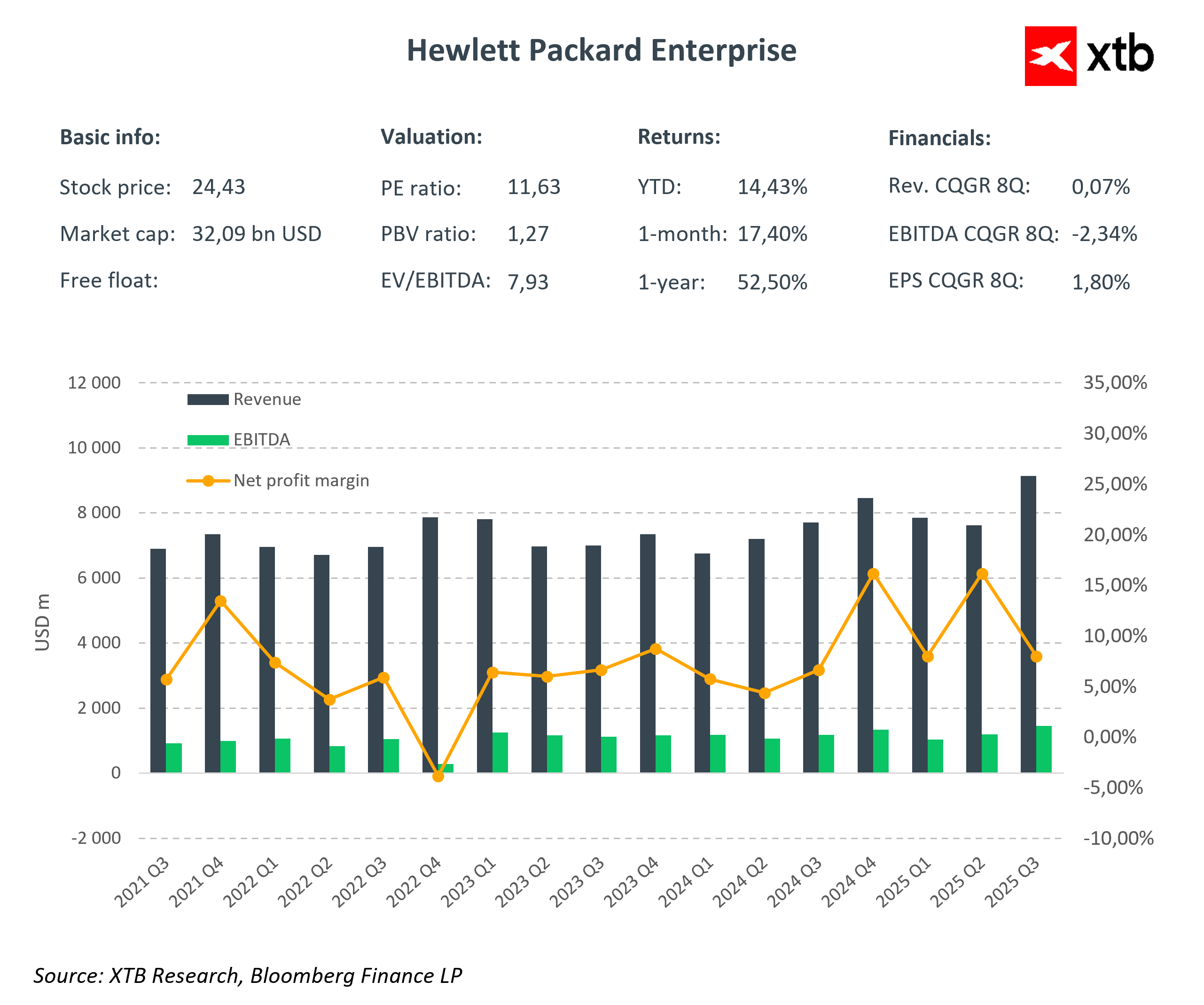
Hewlett Packard Enterprise (HPE.US) reported its Q3 FY2025 results, which positively surprised the market and confirmed the company is steadily executing its growth and transformation strategy. Revenue increased by an impressive 19% year-over-year, reaching $9.13 billion, surpassing analysts’ expectations of $8.96 billion. The key driver of this growth was the acquisition of Juniper Networks, which significantly strengthened HPE’s networking segment, along with rising customer demand for advanced infrastructure solutions and networking technologies, including 5G and hybrid cloud offerings.
The improvement was not limited to revenue. HPE also recorded higher profitability and margins, thanks to effective cost control and the successful integration of newly acquired assets. Adjusted earnings per share (EPS) came in at $0.44, beating market expectations by 4.8% and growing 22% year-over-year. This indicates that the company is not only expanding revenue but also improving operational efficiency, which is critical in the rapidly evolving tech sector.
Key Q3 FY2025 Metrics:
-
Revenue: $9.13B vs. expected $8.96B (+19% YoY)
-
Server segment: Revenue up 16% YoY, reflecting rising demand for AI-optimized and edge computing servers
-
Networking segment: Impressive 54% YoY revenue growth, driven by Juniper Networks integration and demand for SDN and 5G technologies
-
Adjusted EPS: $0.44 vs. expected $0.42 (+22% YoY)
-
Free cash flow: $790M, indicating strong financial health and capacity for continued investment
-
Operating margins: Maintained at stable levels, despite rising component and logistics cost
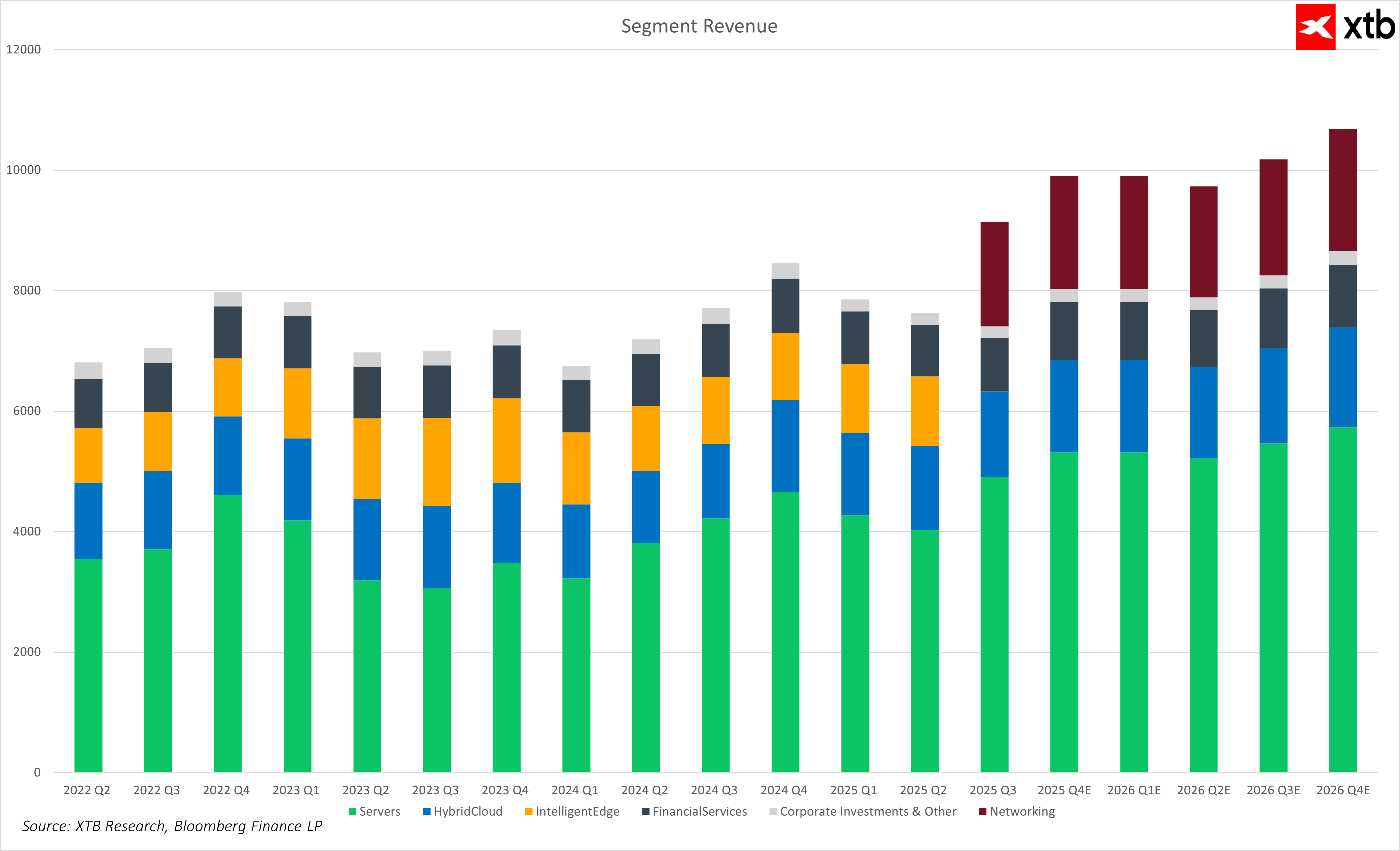
An analysis of the contribution of Hewlett Packard Enterprise’s (HPE) individual segments to the company’s revenue indicates solid foundations and a balanced business structure. The Servers segment remains the most important revenue pillar, currently generating approximately 54% of total income. Maintaining such a significant share reflects the stable position of this segment in the server infrastructure market, which is crucial in the context of the development of cloud solutions and the digital transformation of enterprises.
The Hybrid Cloud segment, accounting for about 15–19% of revenue, is an important part of the company’s strategy, reflecting the growing demand for integrating on-premises environments with the public cloud. The stable contribution of this segment highlights the increasing role of hybrid cloud models as a significant source of revenue for HPE.
The greatest growth potential is seen in the Networking segment, which has increased its share to approximately 19% of revenue since the acquisition of Juniper Networks. In light of rising demand for modern and secure networking solutions, this segment is becoming a key area of development with the potential to significantly increase its share of the company’s total revenue.
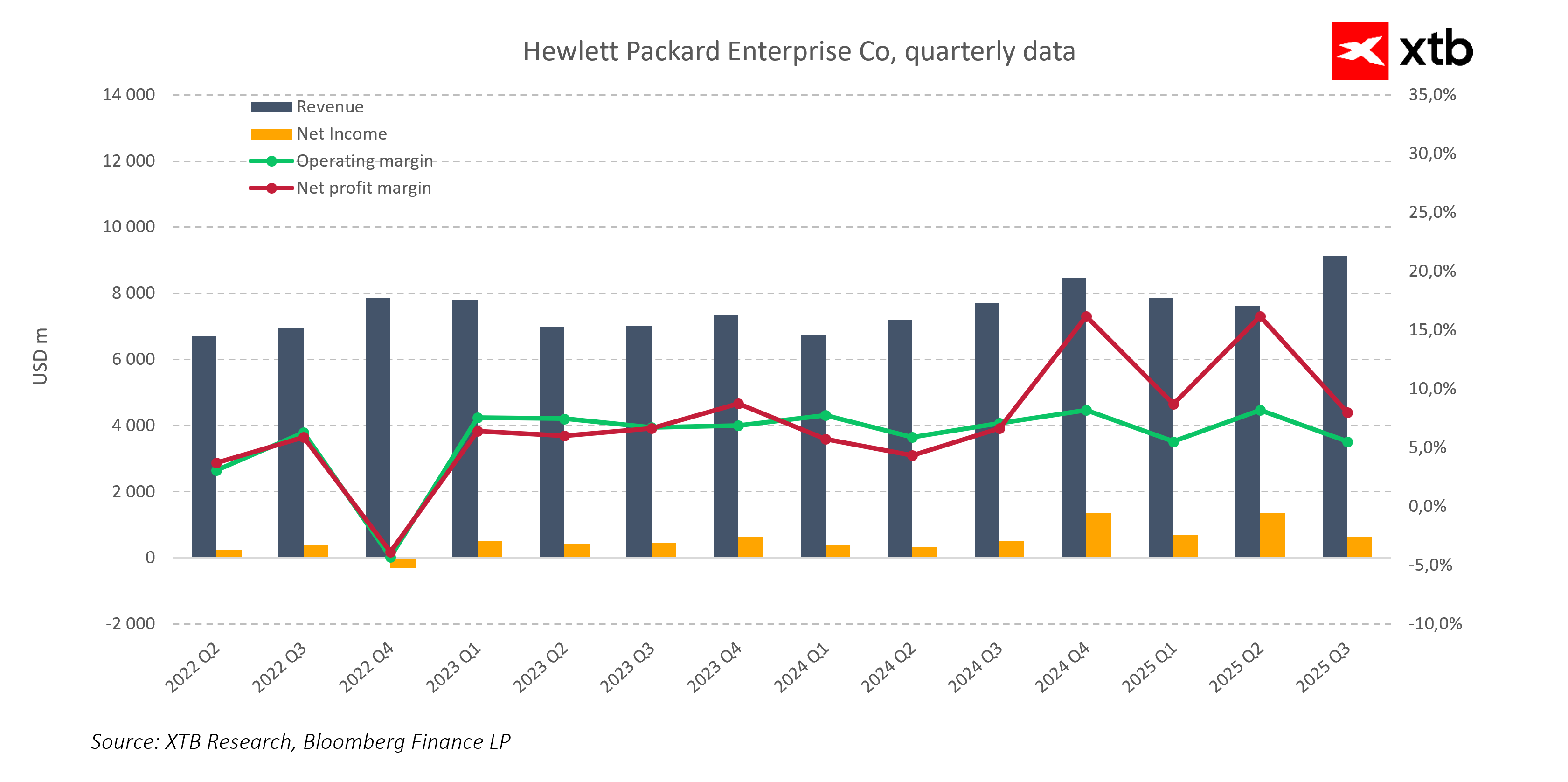
The quarterly financial results chart for Hewlett Packard Enterprise (HPE) from Q2 2022 to Q3 2025 illustrates a clear and sustained increase in the company’s revenue, which accelerated notably in Q3 2025. This dynamic growth is primarily driven by the successful acquisition of Juniper Networks and the strong expansion of the Networking segment, which has become a key growth engine for HPE.
Net profit shows greater volatility; after a significant decline in Q4 2022, there was a strong recovery, reaching a record high in Q2 2025. However, in Q3 2025, a slight decline in net profit is visible, attributed to higher integration costs.
The operating margin remains stable and on the rise, hovering around 6%, reflecting effective cost control and improved operational efficiency. Although more variable, the net margin reached a high level of about 15% in Q2 2025, highlighting the company’s growing ability to generate profits.
Looking ahead, rising operating margins combined with steady revenue growth indicate that HPE is on track to maintain solid and sustainable financial performance. The development of the Networking segment and increasing demand for infrastructure and cloud solutions will continue to drive the company’s positive momentum. Effective integration of new businesses, such as Juniper Networks, along with consistent cost control, should contribute to further profitability improvements.
While short-term net profit volatility calls for caution, overall trends point to rising margins and stable growth, providing a strong foundation for optimistic future forecasts. As a result, HPE has the potential not only to increase its revenues but also to generate increasingly better financial results, which is positive news for investors and the market.
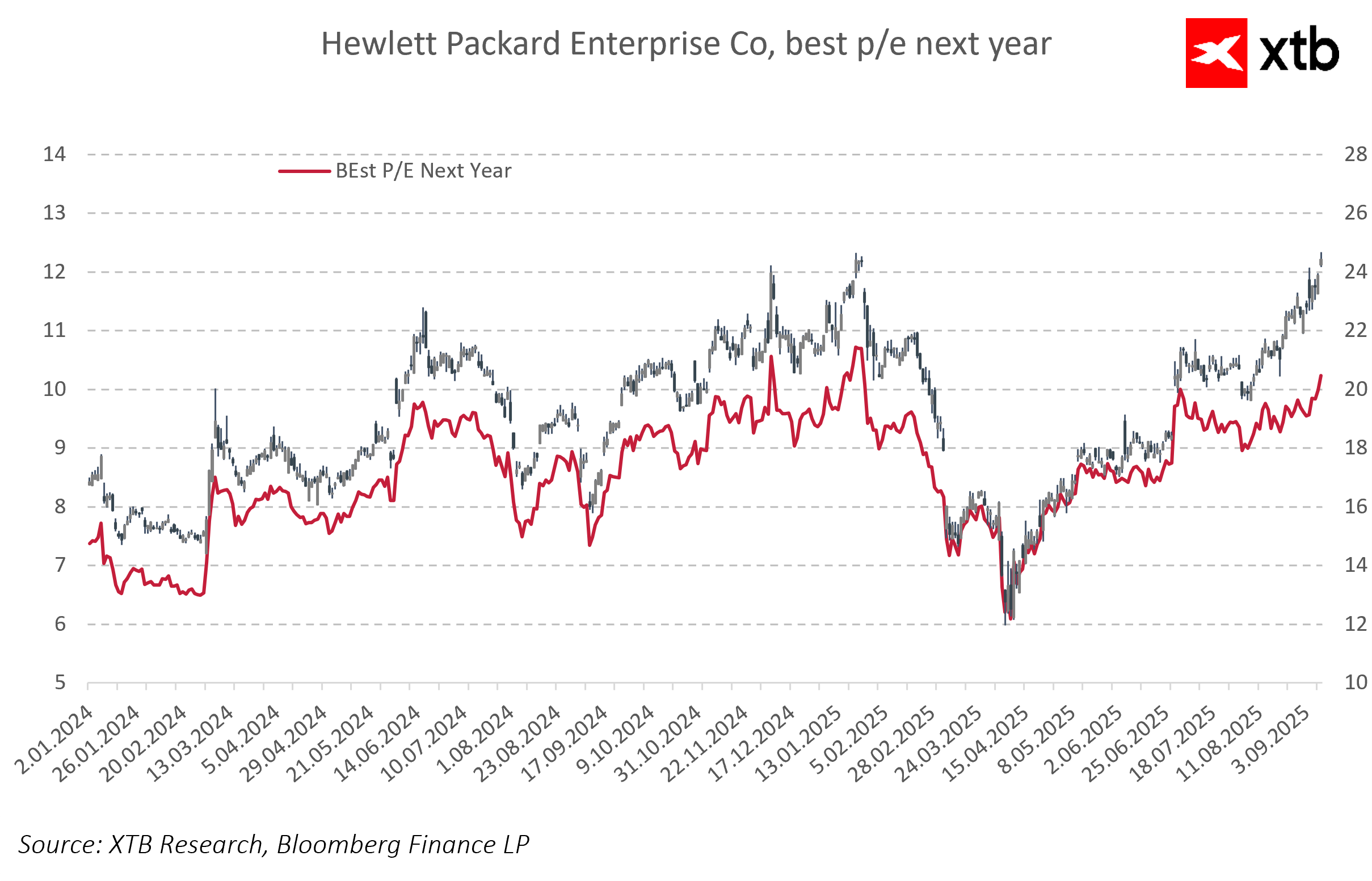
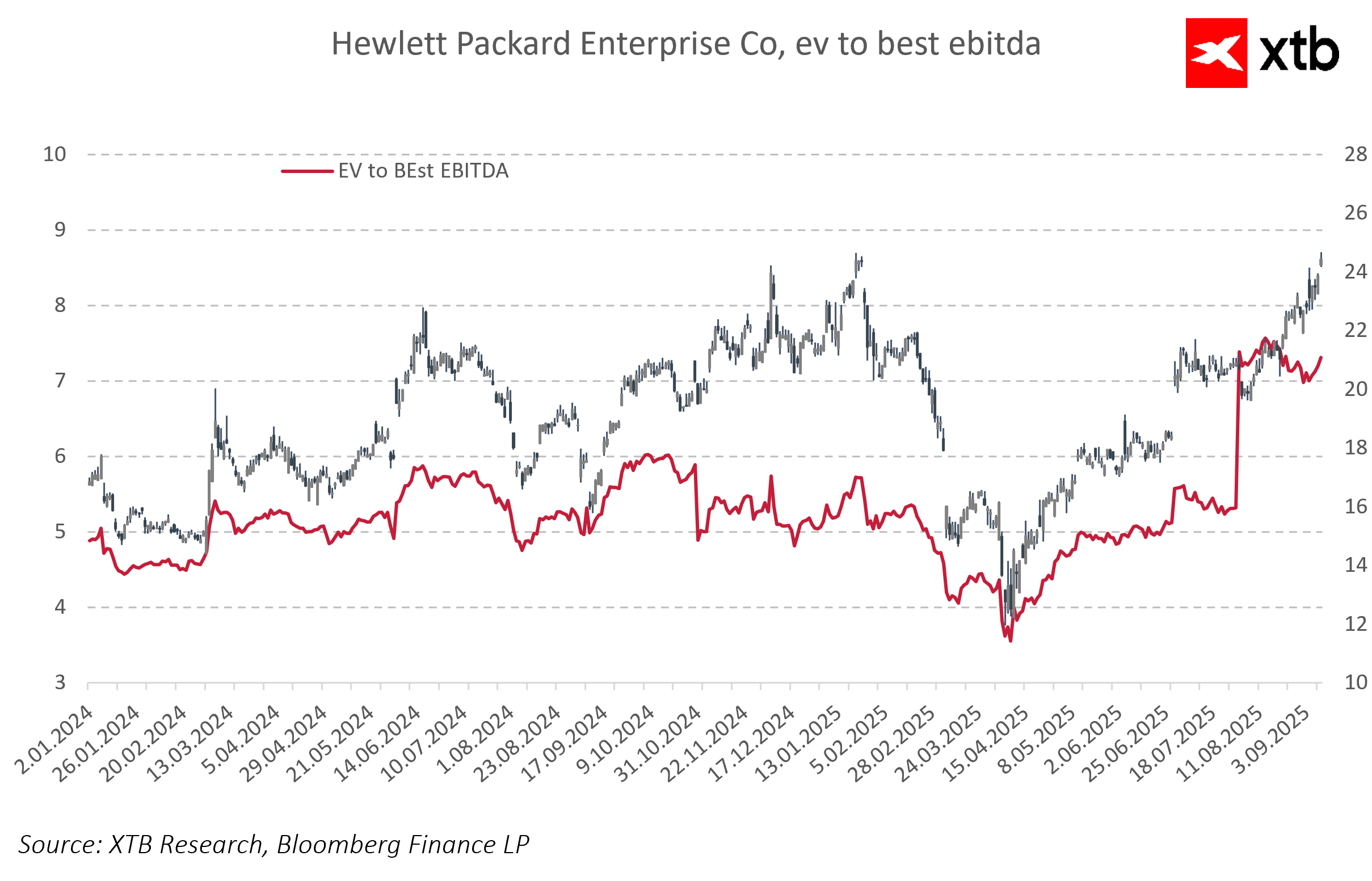
Currently, Hewlett Packard Enterprise is valued by the market at moderate multiples; however, there is a clear upward trend in key valuation metrics such as the P/E ratio (price-to-earnings) and EV/EBITDA. The P/E ratio for the next four quarters is currently around 10.5–11, representing a significant increase compared to the beginning of the year, when it was approximately 7–8. Similarly, the EV/EBITDA ratio has risen from around 4.5 to over 6.5. This movement in multiples may indicate growing investor confidence in the company’s continued growth and improving financial performance.
It is worth noting that both metrics, P/E and EV/EBITDA, have been following an upward trend that started in mid-2024. Since then, the market has steadily increased the company’s valuation, likely driven by improving financial forecasts and growing interest in the AI segment, where HPE is expanding its operations. On the other hand, the rapid rise in multiples may also suggest that investor expectations are somewhat ahead of the fundamentals, with the market beginning to price in future earnings before they have actually materialized.
Revenue Outlook
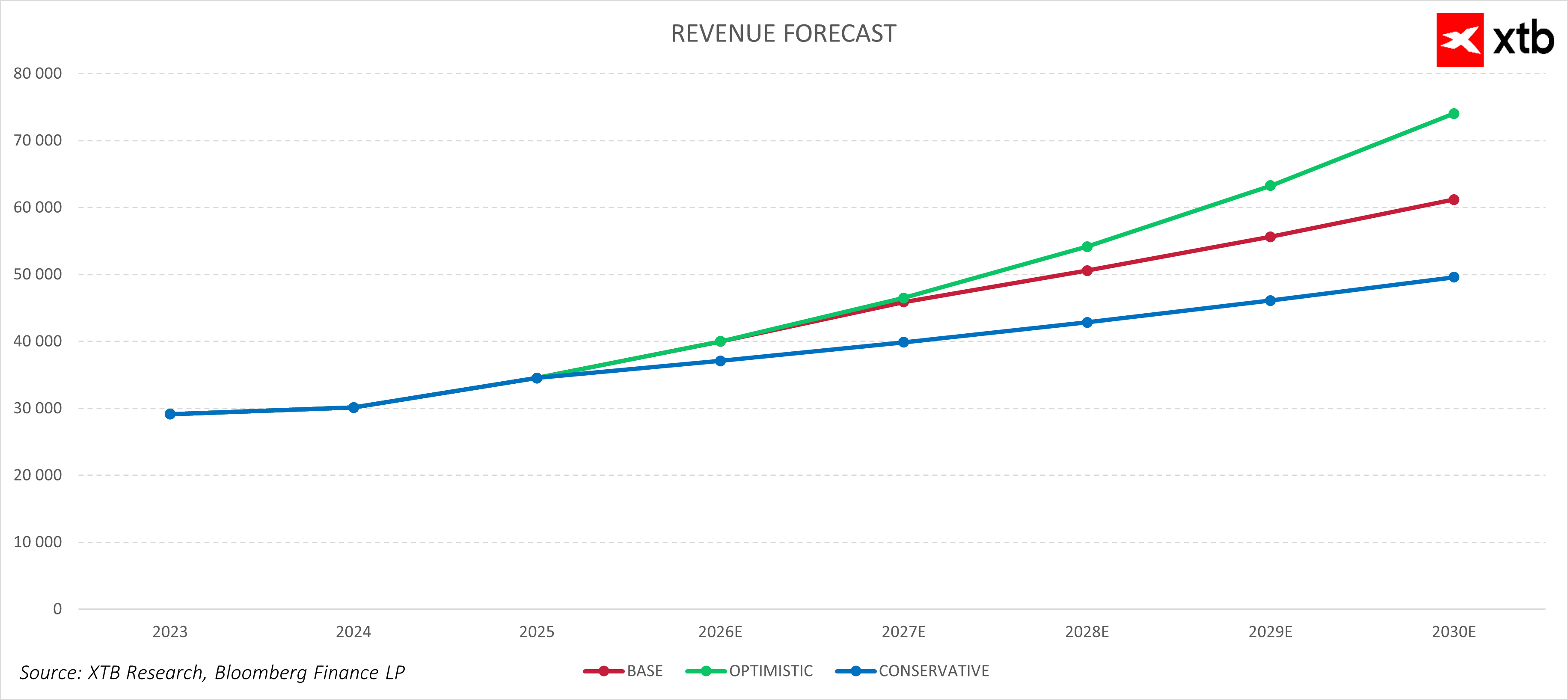
Hewlett Packard Enterprise (HPE) currently faces the prospect of dynamic growth, reflected in revenue forecasts for the coming years. The company is entering the race in artificial intelligence and is increasingly focusing on this area, which translates into growing importance of AI-based segments. HPE is intensifying monetization of AI-related solutions and services, as well as hybrid cloud offerings, which are becoming key growth drivers for the company.
The revenue forecast chart presents three scenarios for the company’s development: base, optimistic, and conservative. In the base scenario, revenues grow steadily from approximately $30 billion in 2024 to about $63 billion in 2030, reflecting realistic market expectations based on current trends. In this scenario, the company rapidly expands its main business segments in the early years, with growth moderating somewhat in later years due to market maturation and saturation.
The optimistic scenario assumes faster growth, leading to nearly $74 billion in revenues by 2030, consistent with strong demand for AI technologies and digital transformation. This scenario envisions uninterrupted, dynamic development of key segments such as servers, infrastructure solutions, and networking, which drive the company’s further expansion.
The conservative scenario foresees more moderate growth, with revenues around $50 billion in 2030. This scenario assumes a cautious approach, accounting for potential market challenges, increased competition, and possible slowdowns in technology adoption.
HPE is investing in advanced technologies and expanding its presence in AI-related segments, which is crucial for further growth and improving financial results. This prepares the company to effectively capitalize on the rising demand for advanced IT solutions, enabling it to achieve ambitious growth targets and build a competitive edge.
Valuation Overview
Let us now examine Hewlett Packard Enterprise’s (HPE) valuation using the discounted cash flow (DCF) method. It is important to note that the following valuation is for informational purposes only and should not be considered as investment advice or an exact target stock price.
Our assumptions include differentiated average annual revenue growth rates across HPE’s business segments. The Servers segment is developing dynamically, starting with an annual growth rate of about 20%, which gradually slows over the forecast period. A similar trend is observed in the Networking segment, which also starts with approximately 20% growth and then tapers off.
The HybridCloud segment exhibit more stable growth, maintaining an annual growth rate of approximately 10-15% throughout the forecast period. Other segments, such as Financial Services and Corporate Investments, grow more slowly but steadily, with a consistent moderate growth pace.
The assumed growth rates reflect the market position and development prospects of each segment. The Servers and Networking segments benefit from increasing demand for IT infrastructure and networking solutions that drive digital transformation, cloud technology, and AI development. However, due to rising competition and market maturity, we expect a gradual slowdown in growth for these segments.
Conversely, HybridCloud segment has long-term growth potential due to the increasing adoption of hybrid solutions and intelligent infrastructure in enterprises. Therefore, we forecast stable, moderate growth here.
Financial Services and Corporate Investments, as supporting areas, develop more slowly, and we applied conservative, steady growth rates reflecting their smaller impact on the company’s revenue.
Despite the anticipated slowdown in growth rates for most segments over the forecast period, revenue momentum remains solid, allowing HPE to continue stable development and strengthen its market position.
A key element of the valuation was determining the weighted average cost of capital (WACC). Based on current market data and the specifics of the technology sector, we estimated the cost of equity at about 8%. Hewlett Packard Enterprise maintains a moderate debt level, resulting in a relatively low proportion of debt cost in the total WACC. The model assumes a terminal growth rate of 2% for residual value, with other parameters based on average financial results from recent years.
The DCF valuation of Hewlett Packard Enterprise (HPE) amounted to $61.49 per share, which is over 152% higher than the current closing price. The technology sector, in which HPE operates — encompassing cloud solutions, IT infrastructure, and artificial intelligence — is one of the fastest-growing and most dynamic market areas. Therefore, valuations of companies like HPE often exceed traditional models based on historical data, reflecting high expectations for future growth and innovation.
For this reason, although the DCF method remains a valuable analytical tool, when investing in technology companies like HPE, it is also important to consider market factors, innovation, and the overall sector dynamics, which can cause significant differences from fundamental valuations.
The valuation largely depends on assumptions regarding revenue growth rates and the cost of capital. Below, we present a scenario matrix illustrating how changes in these parameters affect the company’s valuation.
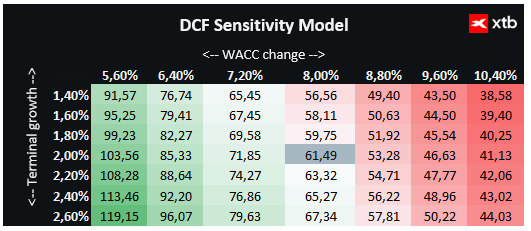
Source: xStation5
A Look at the Chart
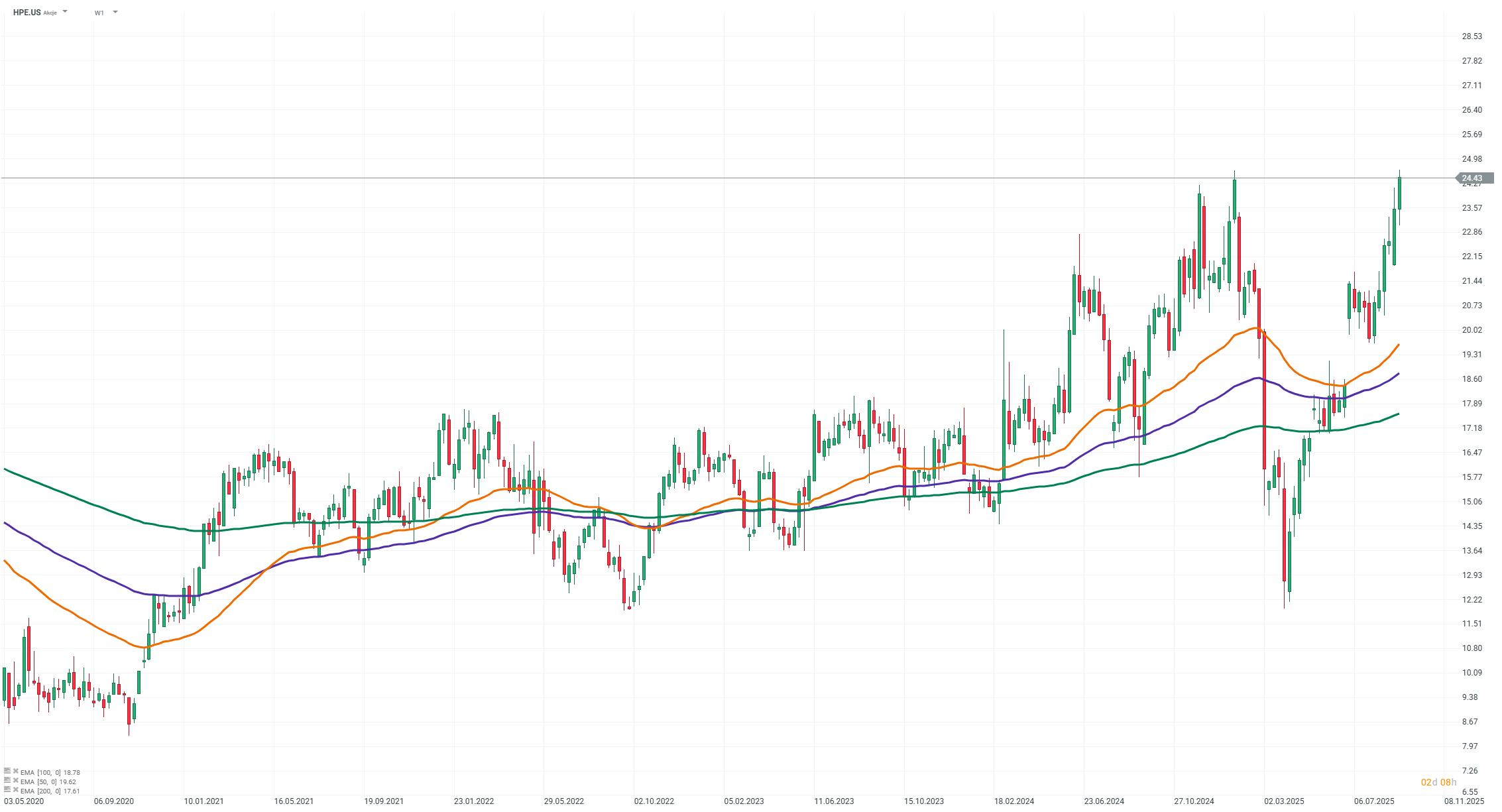
From a technical analysis perspective, Hewlett Packard Enterprise (HPE) shares exhibit a clear upward trend. The EMA 50 (orange), EMA 100 (purple), and EMA 200 (green) moving averages form a classic bullish sequence, confirming the strength of the trend. The price remains above all key moving averages, and price corrections are relatively shallow and quickly absorbed by buyers.
The recent price increase confirms strong demand for HPE shares, likely driven by positive market expectations regarding the company’s continued growth and its position in the cloud solutions and IT infrastructure sector.
The content of this report has been created by XTB S.A., with its registered office in Warsaw, at Prosta 67, 00-838 Warsaw, Poland, (KRS number 0000217580) and supervised by Polish Supervision Authority ( No. DDM-M-4021-57-1/2005). This material is a marketing communication within the meaning of Art. 24 (3) of Directive 2014/65/EU of the European Parliament and of the Council of 15 May 2014 on markets in financial instruments and amending Directive 2002/92/EC and Directive 2011/61/EU (MiFID II). Marketing communication is not an investment recommendation or information recommending or suggesting an investment strategy within the meaning of Regulation (EU) No 596/2014 of the European Parliament and of the Council of 16 April 2014 on market abuse (market abuse regulation) and repealing Directive 2003/6/EC of the European Parliament and of the Council and Commission Directives 2003/124/EC, 2003/125/EC and 2004/72/EC and Commission Delegated Regulation (EU) 2016/958 of 9 March 2016 supplementing Regulation (EU) No 596/2014 of the European Parliament and of the Council with regard to regulatory technical standards for the technical arrangements for objective presentation of investment recommendations or other information recommending or suggesting an investment strategy and for disclosure of particular interests or indications of conflicts of interest or any other advice, including in the area of investment advisory, within the meaning of the Trading in Financial Instruments Act of 29 July 2005 (i.e. Journal of Laws 2019, item 875, as amended). The marketing communication is prepared with the highest diligence, objectivity, presents the facts known to the author on the date of preparation and is devoid of any evaluation elements. The marketing communication is prepared without considering the client’s needs, his individual financial situation and does not present any investment strategy in any way. The marketing communication does not constitute an offer of sale, offering, subscription, invitation to purchase, advertisement or promotion of any financial instruments. XTB S.A. is not liable for any client’s actions or omissions, in particular for the acquisition or disposal of financial instruments, undertaken on the basis of the information contained in this marketing communication. In the event that the marketing communication contains any information about any results regarding the financial instruments indicated therein, these do not constitute any guarantee or forecast regarding the future results.

